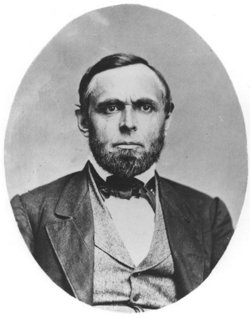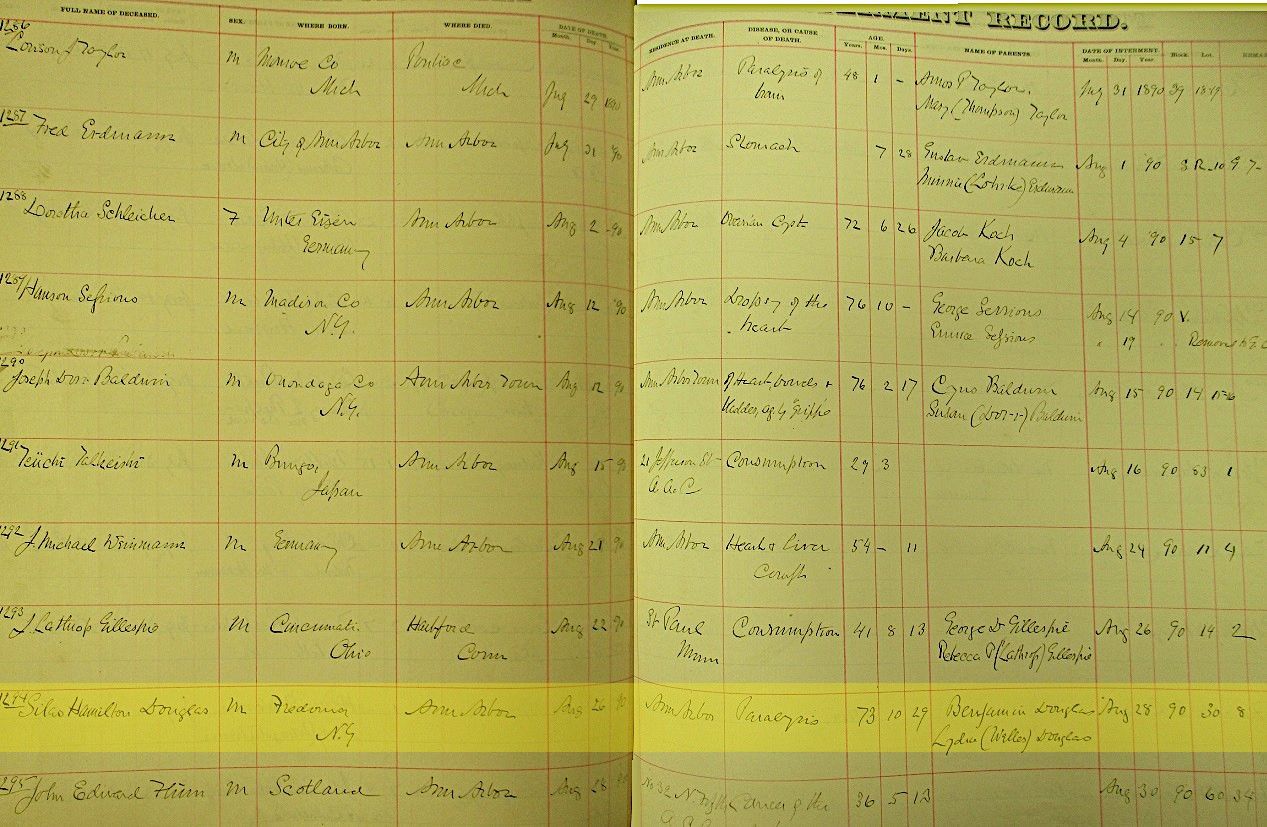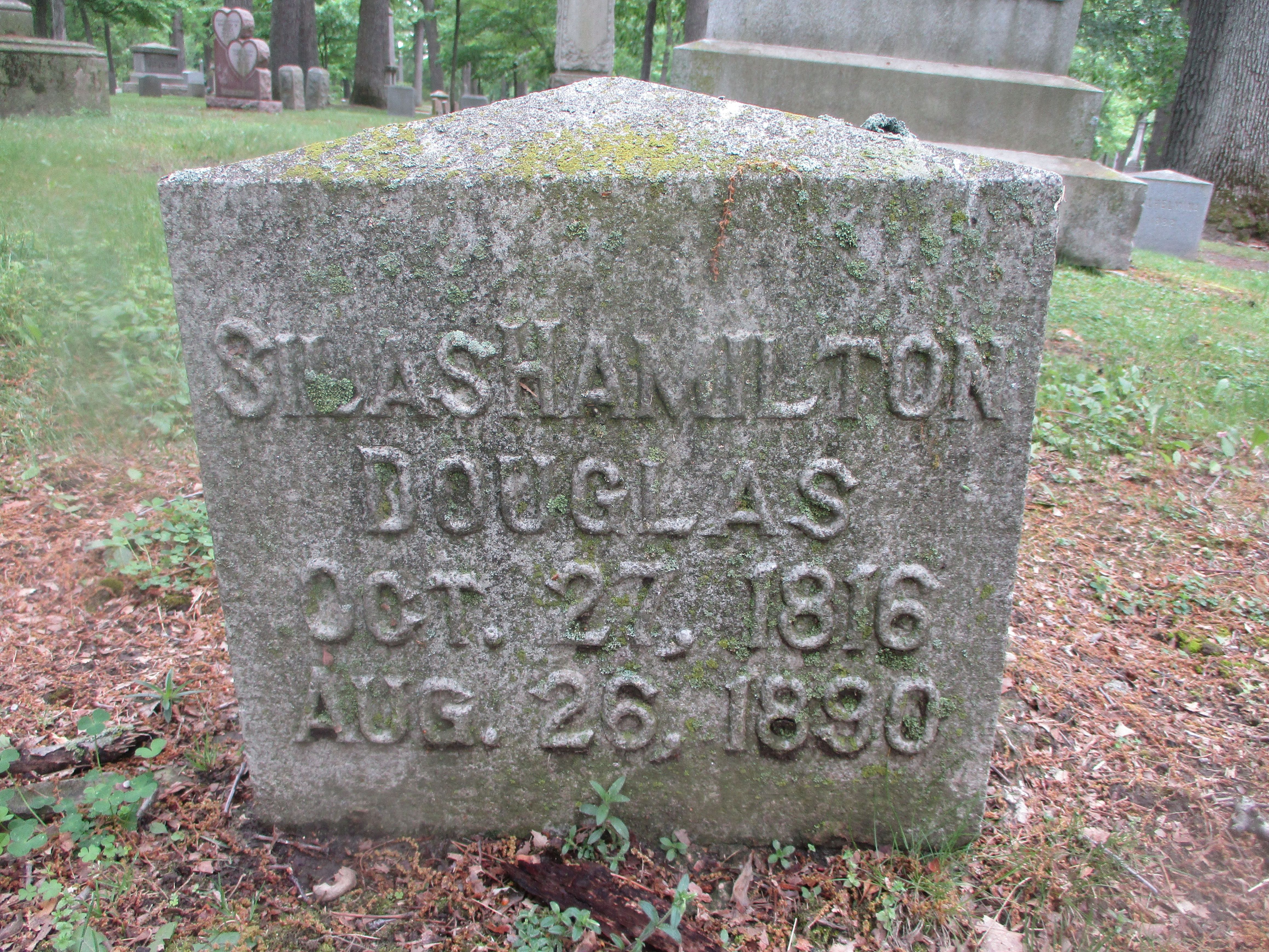From the Saline, Michigan Observer, Thursday, September 4, 1890:
Dr. Silas H. Douglas, for some years connected with the Michigan University, and whose name was brought prominently before the people by its connection with the Rose-Douglas case, died at his home in Ann Arbor last week.
from Wiki Source:
Douglas, Silas Hamilton (1816–1890).
Silas Hamilton Douglas, physiologist, was born in Fredonia, Chautauqua County, New York, October 16, 1816, and had his general education in the Academy there and at the New York University. In 1838 he came to Detroit and studied medicine under Dr. Zina Pitcher (q. v.) in 1841–42, taking a course of lectures at the Medical Department of the University of Maryland, and on June 3, 1842, was licensed to practise by the Censors, Michigan State Medical Society. At various times he accompanied Dr. Douglas Houghton (q. v.) on his geological surveys of Michigan and was employed as a physician on the staff of Henry R. Schoolcraft, in 1843 beginning to practise at Ann Arbor. The year 1844 saw him assistant to Prof. Houghton in the university, and in charge of chemistry during the professor's absence in the field, a duty which under various titles he conducted during the next thirty-two years after Dr. Houghton's death. For several years he used a private chemical laboratory for teaching, but in 1856 the Regents, at his solicitation, erected a chemical laboratory at a cost of six thousand dollars and made practical chemistry a part of the curriculum. This was his great contribution to medical teaching—the initiation of laboratory training for the degree of M. D. He was largely interested in the founding of the medical department, and remained with it until 1877, and had also charge of the erection of the observatory building at the university, the medical building, and other university works, doing good work as well in organizing the Ann Arbor water and gas works. While on his geological tours he collected a large cabinet of minerals which he gave to the university. The latter years of his life were embittered by a controversy over his accounts with the university, the matter finally reaching the Supreme Court, and being decided in his favor.
On May 1, 1845, Dr. Douglas married Helen Wells, who with seven children survived him when he died in Ann Arbor, August 26, 1890, from paralysis.
His chief writings included: "Common Sense in Ventilation," Michigan University Medical Journal, vol. i.; "Method of Conducting Postmortem Examinations in Cases of Suspected Poisoning," Peninsular Medical Journal. vol. i.; "On the Analysis of Waters," Peninsular Medical Journal, vol. i.; "Michigan Coal; Its Analysis and Value for Gas," Peninsular Medical Journal, vol. iv. He was the author of a system of chemical tables which passed through four editions and which, enlarged by the aid of Prof. A. B. Prescott, M. D., into a text-book on "Qualitative Chemical Analysis," met a wide acceptance (three editions).
---- as suggested by EmptySea
From the Saline, Michigan Observer, Thursday, September 4, 1890:
Dr. Silas H. Douglas, for some years connected with the Michigan University, and whose name was brought prominently before the people by its connection with the Rose-Douglas case, died at his home in Ann Arbor last week.
from Wiki Source:
Douglas, Silas Hamilton (1816–1890).
Silas Hamilton Douglas, physiologist, was born in Fredonia, Chautauqua County, New York, October 16, 1816, and had his general education in the Academy there and at the New York University. In 1838 he came to Detroit and studied medicine under Dr. Zina Pitcher (q. v.) in 1841–42, taking a course of lectures at the Medical Department of the University of Maryland, and on June 3, 1842, was licensed to practise by the Censors, Michigan State Medical Society. At various times he accompanied Dr. Douglas Houghton (q. v.) on his geological surveys of Michigan and was employed as a physician on the staff of Henry R. Schoolcraft, in 1843 beginning to practise at Ann Arbor. The year 1844 saw him assistant to Prof. Houghton in the university, and in charge of chemistry during the professor's absence in the field, a duty which under various titles he conducted during the next thirty-two years after Dr. Houghton's death. For several years he used a private chemical laboratory for teaching, but in 1856 the Regents, at his solicitation, erected a chemical laboratory at a cost of six thousand dollars and made practical chemistry a part of the curriculum. This was his great contribution to medical teaching—the initiation of laboratory training for the degree of M. D. He was largely interested in the founding of the medical department, and remained with it until 1877, and had also charge of the erection of the observatory building at the university, the medical building, and other university works, doing good work as well in organizing the Ann Arbor water and gas works. While on his geological tours he collected a large cabinet of minerals which he gave to the university. The latter years of his life were embittered by a controversy over his accounts with the university, the matter finally reaching the Supreme Court, and being decided in his favor.
On May 1, 1845, Dr. Douglas married Helen Wells, who with seven children survived him when he died in Ann Arbor, August 26, 1890, from paralysis.
His chief writings included: "Common Sense in Ventilation," Michigan University Medical Journal, vol. i.; "Method of Conducting Postmortem Examinations in Cases of Suspected Poisoning," Peninsular Medical Journal. vol. i.; "On the Analysis of Waters," Peninsular Medical Journal, vol. i.; "Michigan Coal; Its Analysis and Value for Gas," Peninsular Medical Journal, vol. iv. He was the author of a system of chemical tables which passed through four editions and which, enlarged by the aid of Prof. A. B. Prescott, M. D., into a text-book on "Qualitative Chemical Analysis," met a wide acceptance (three editions).
---- as suggested by EmptySea
Family Members
Advertisement
Explore more
Sponsored by Ancestry
Advertisement
















